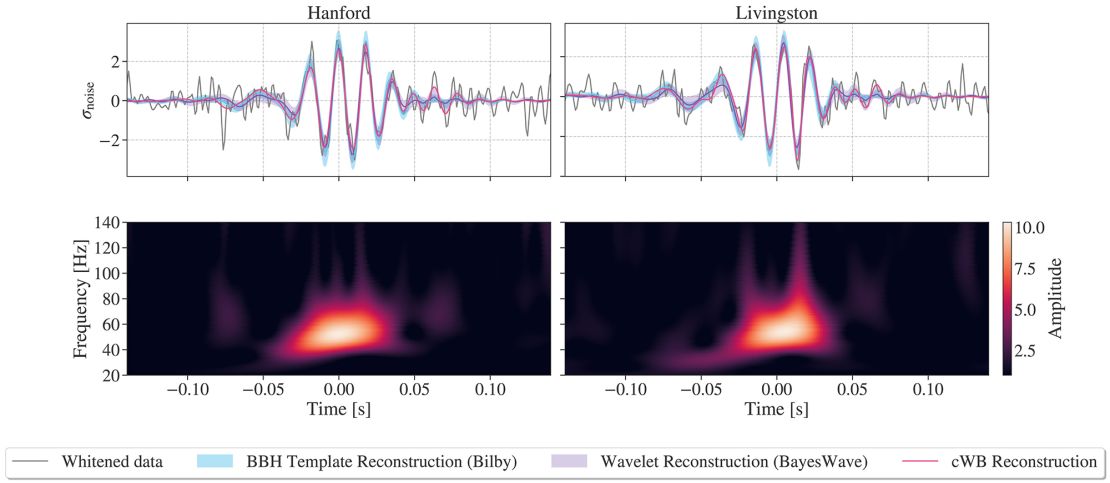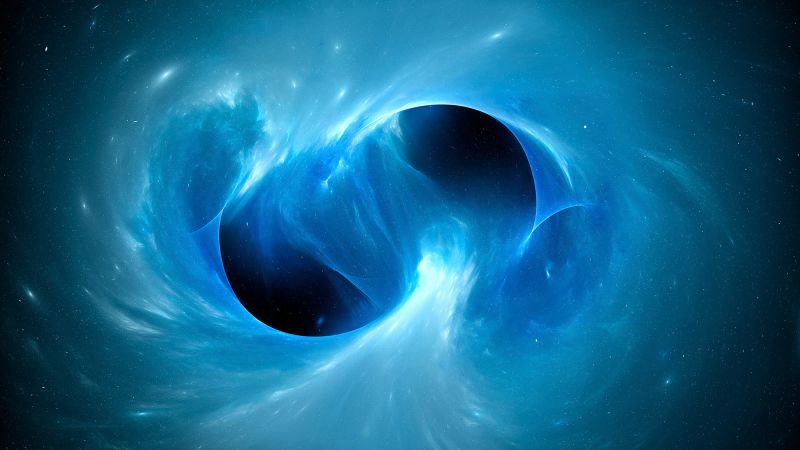Sign up for CNN’s Wonder Theory science newsletter. Explore the universe with news on fascinating discoveries, scientific advancements and more.
CNN
—
A collision observed between two black holes, each more massive than a hundred suns, is the largest merger of its kind ever recorded, according to new research.
A team of astronomers discovered the event, dubbed GW231123, when the Laser Interferometer Gravitational-Wave Observatory (LIGO) — a pair of identical instruments located in Livingston, Louisiana, and Hanford, Washington — detected faint ripples in space-time produced by two black holes slamming into each other. Physicists call such ripples gravitational waves.
Gravitational waves were predicted by Albert Einstein in 1915 as part of his theory of relativity, but he thought they were too weak to ever be discovered by human technology. In 2016, however, LIGO detected them for the very first time when black holes collided, proving Einstein right (once again). The following year, three scientists received awards for their key contributions to the development of what has been colloquially called a “black hole telescope.”
Since the first detection of gravitational waves, LIGO and its sister instruments — Virgo in Italy, and KAGRA in Japan — have picked up signs of about 300 black hole mergers. “These amazing detectors are really the most sensitive measuring instruments that human beings have ever built,” said Mark Hannam, head of Gravity Exploration Institute at Cardiff University in the UK and a member of the LIGO Scientific Collaboration. “So, we’re observing the most violent and extreme events in the universe through the smallest measurements we can make.”
GW231123, however, is exceptional among those 300 black hole mergers, and not just because it is the most massive of the collisions.
“The individual black holes are special because they lie in a range of masses where we do not expect them to be produced from dying stars,” said Charlie Hoy, a research fellow at the University of Plymouth in the UK who’s also a member of the LIGO Scientific Collaboration. “As if this wasn’t enough,” he continued, “the black holes are also likely spinning almost as fast as physically possible. GW231123 presents a real challenge to our understanding of black hole formation.”
Gravitational waves are the only way scientists can observe a collision in a binary system in which two black holes orbit each other. “Before we could observe them with gravitational waves, there was even a question of whether black hole binaries even existed,” Hannam said. “Black holes don’t give off any light or any other electromagnetic radiation, so any kind of regular telescope is unable to observe them.”
According to Einstein’s theory of general relativity, gravity is a stretching of space and time, and it forces objects to move through curved space. When objects move very rapidly, like spinning black holes, the curved space forms ripples that spread outward like waves.
These gravitational waves are “ridiculously weak,” according to Hannam, and there are limitations to the information they can provide. For example, there’s uncertainty about the distance of GW231123 from Earth; it could be up to 12 billion light-years away. Hannam is more confident about the mass of the two black holes, which are believed to be approximately 100 and 140 times the mass of the sun.
Those numbers, however, are puzzling: “There are standard mechanisms where black holes form — when stars run out of fuel and die and then collapse,” Hannam said. “But there’s a range of masses where we think that it’s not possible for black holes to form that way. And the black holes from GW231123 live bang in the middle of that (mass) gap. So there’s a question of how they formed and that makes them pretty interesting.”
The “mass gap” Hannam refers to starts at about 60 solar masses and goes up to roughly 130, but because it is a theoretical range, meaning it has not been directly observed, there is some uncertainty about where this gap starts and where it ends. But if the black holes from GW231123 indeed fall into this gap, then they likely didn’t form from stars collapsing, but in some other way.
In a study published Monday on the open access repository Arxiv, Hannam and his colleagues suggest that the “mass gap” could be explained if the two black holes are the results of previous mergers, rather than the product of dying stars. “This is a mechanism that people have talked about in the past and we’ve seen hints of before,” he said.

In this scenario, a chain reaction of black hole mergers occurs. “You can have this process where you just build up more and more massive black holes. And since the black holes in GW231123 look like they’re at masses where you couldn’t get them by normal mechanisms, this is a strong hint that this other process is going on where you have these successive mergers,” Hannam explained.
If this hypothesis were to be confirmed, it would suggest the existence of an unexpected population of black holes that, in terms of mass, fall somewhere between black holes that form from the death of massive stars and the supermassive black holes that are found in the centers of galaxies, said Dan Wilkins, a research scientist at the Kavli Institute for Particle Astrophysics and Cosmology of Stanford University. Wilkins was not involved with the GW231123 discovery.
“Gravitational waves are opening a really interesting window into black holes, and are revealing some really intriguing mysteries,” he added. “Before the advent of gravitational wave astronomy, we could only detect black holes that are actively growing by pulling in material, producing a powerful light source. Gravitational waves are showing us a different part of the black hole population that is growing not by pulling in material, but instead by merging with other black holes.”
The other surprising feature of GW231123 is how quickly the two black holes are spinning around each other.
“So far, most black holes we have found with gravitational waves have been spinning fairly slowly,” said Charlie Hoy. “This suggests that GW231123 may have formed through a different mechanism compared to other observed mergers, or it could be a sign that our models need to change.”
Such high-speed spins are hard to produce, but they also support the idea that the black holes had undergone prior mergers, because scientists would expect previously merged black holes to spin faster, according to Hannam.
“GW231123 challenges our models of gravitational wave signals, as it is complex to model such (fast) spins, and it stands out as an extraordinary event that is puzzling to interpret,” said Sophie Bini, a postdoctoral researcher at Caltech and a member of the LIGO-Virgo-KAGRA Collaboration. “What surprised me the most is how much there is still to learn about gravitational waves. I really hope that in the future we can observe other events similar to GW231123 to improve our understanding of such systems.”
The previous record for the most massive black hole merger ever observed belonged to a merger called GW190521, which was only 60% as big as GW231123. But scientists could find even more massive mergers in the future, Hannam said, and the collisions might one day be observed through even more accurate instruments that could become available the next couple of decades, such as the proposed Cosmic Explorer in the US and the Einstein Telescope in Europe.
This new discovery opens a new window on how black holes can form and grow, said Imre Bartos, an associate professor at the University of Florida who was not involved with the research. “It also shows how quickly gravitational wave astronomy is maturing,” he added. “In less than a decade we’ve moved from first detection to charting territory that challenges our best theories.”
While he agrees that previous mergers could explain both the high mass and the fast spin of the black holes, other possibilities include repeated collisions in young star clusters or the direct collapse of an unusually massive star. He added, however, that those possibilities would be less likely to produce black holes that spin this fast.
It is very natural to explain the black holes in GW231123 as remnants of one or even multiple generations of previous mergers, said Zoltan Haiman, a professor at the Institute of Science and Technology Austria who also was not involved with the discovery. “This idea was already raised immediately after the first ever LIGO detection of a (black hole) merger, but this new merger is very hard to explain in other ways.”
Future detections, he added, will tell us “whether this heavyweight bout was a one‑off or the tip of a very hefty iceberg.”
